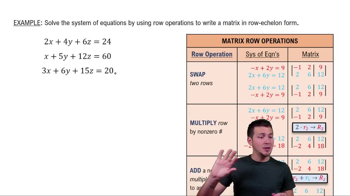Table of contents
- 0. Review of Algebra4h 16m
- 1. Equations & Inequalities3h 18m
- 2. Graphs of Equations43m
- 3. Functions2h 17m
- 4. Polynomial Functions1h 44m
- 5. Rational Functions1h 23m
- 6. Exponential & Logarithmic Functions2h 28m
- 7. Systems of Equations & Matrices4h 6m
- 8. Conic Sections2h 23m
- 9. Sequences, Series, & Induction1h 19m
- 10. Combinatorics & Probability1h 45m
7. Systems of Equations & Matrices
Introduction to Matrices
Problem 15e
Textbook Question
In Exercises 9–42, write the partial fraction decomposition of each rational expression. 4/(2x^2 -5x -3)
 Verified step by step guidance
Verified step by step guidance1
<Step 1: Factor the denominator.> The first step in partial fraction decomposition is to factor the denominator of the rational expression. For the expression \( \frac{4}{2x^2 - 5x - 3} \), factor the quadratic expression \( 2x^2 - 5x - 3 \).
<Step 2: Set up the partial fraction decomposition.> Once the denominator is factored, express the rational expression as a sum of fractions with unknown coefficients. If the denominator factors into \((ax + b)(cx + d)\), the decomposition will be \( \frac{A}{ax + b} + \frac{B}{cx + d} \).
<Step 3: Multiply through by the common denominator.> Multiply both sides of the equation by the common denominator to eliminate the fractions. This will give you an equation involving polynomials.
<Step 4: Expand and collect like terms.> Expand the right side of the equation and collect like terms to form a polynomial equation. This will help in equating coefficients.
<Step 5: Solve for the unknown coefficients.> Equate the coefficients of corresponding terms on both sides of the equation to form a system of equations. Solve this system to find the values of the unknown coefficients \(A\) and \(B\).
Recommended similar problem, with video answer:
 Verified Solution
Verified SolutionThis video solution was recommended by our tutors as helpful for the problem above
Video duration:
8mPlay a video:
Was this helpful?
Key Concepts
Here are the essential concepts you must grasp in order to answer the question correctly.
Rational Expressions
A rational expression is a fraction where both the numerator and the denominator are polynomials. Understanding rational expressions is crucial for performing operations such as addition, subtraction, multiplication, and division, as well as for decomposing them into simpler fractions, which is often necessary for integration and solving equations.
Recommended video:
Guided course

Rationalizing Denominators
Partial Fraction Decomposition
Partial fraction decomposition is a technique used to express a rational function as a sum of simpler fractions. This method is particularly useful when integrating rational expressions, as it allows for easier manipulation and integration of each term. The process involves factoring the denominator and expressing the original fraction in terms of its simpler components.
Recommended video:

Decomposition of Functions
Factoring Polynomials
Factoring polynomials is the process of breaking down a polynomial into simpler components, or factors, that when multiplied together yield the original polynomial. This is essential in partial fraction decomposition, as the first step is to factor the denominator completely to identify the appropriate form for the decomposition, which can include linear and irreducible quadratic factors.
Recommended video:
Guided course

Introduction to Factoring Polynomials

 4:35m
4:35mWatch next
Master Introduction to Matrices with a bite sized video explanation from Patrick Ford
Start learningRelated Videos
Related Practice











